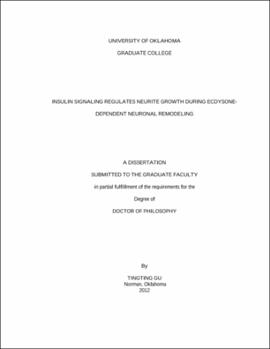| dc.description.abstract | The morphological rearrangement of neurons to accommodate new functions or activities is called "neuronal remodeling". Although neuronal remodeling is an important feature of nervous systems, the mechanisms governing the transition of neurons, from relatively stable states to more dynamic and differentiative remodeling states, are largely unknown. In holometabolous insects, there is a major transition from maintenance growth to organizational growth near the onset of metamorphosis, and these changes provide an unparalleled opportunity to explore the underlying mechanisms of neuronal remodeling. Many differentiated larval neurons are maintained throughout metamorphosis and undergo extensive remodeling, which involves the elimination of larval dendrites and axons (neurites) and the outgrowth and elaboration of adult-specific projections (Levine and Truman 1982; Brown, Cherbas et al. 2006). Here, I show that a metamorphosis-specific increase in insulin and insulin-like-growth factor signaling (IIS) promotes neuronal growth and axon branching after a long period of morphological stability during the larval stages. In a previous gain-of-function genetic screen, we found that overexpression of a negative effector in the IIS pathway, Forkhead box, sub-group O (FOXO), blocked the metamorphic growth of peptidergic neurons that secrete crustacean cardioactive peptide (CCAP) and bursicon. RNA interference (RNAi) and CCAP/bursicon cell-targeted expression of dominant negative constructs for other components of the IIS pathway [Insulin-like receptor (InR), Pi3K92E, Akt1, and S6K] also partially suppressed the growth of the CCAP/bursicon neuron somata and neurite arborization. In contrast, expression of wild-type or constitutively active forms of InR, Pi3K92E, Akt1, Rheb, and Target of rapamycin (TOR), as well as RNAi for negative regulators of the IIS pathway (PTEN and FOXO), stimulated overgrowth. Interestingly, InR displayed little effect on larval growth of the CCAP/bursicon neurons, but strong effects on the metamorphic outgrowth of these neurons. In addition, manipulations of IIS in a pan-peptidergic neuronal pattern revealed a general role in promoting organizational outgrowth of many neurons during metamorphosis. These results reveal that specific activation of IIS during metamorphosis facilitates renewed organizational growth in mature neurons. In order to further elucidate the molecular and cellular mechanisms governing IIS regulation of the metamorphic remodeling, I performed a genetic modifier screen to detect IIS-interacting genes. I screened 492 deficiency lines for modifiers of a foxo overexpression phenotype (wing expansion defects). A total of 14 deficiencies were confirmed as suppressors of foxo, and 19 were confirmed as enhancers. Two selected suppressors, Df(1)Exel6221 and Df(1)Exel6002, strongly reversed the effects of foxo on neuronal outgrowth. Df(1)Exel6221 also significantly rescued the phenotypes produced by expression of InRDN, suggesting that the gene(s) within Df(1)ExEL6221 might be involved in IIS-mediated growth during the neuronal remodeling process. The source of suppression in Df(1)Exel6002 was mapped to an individual locus, Su(z)2. Reduced expression of Su(z)2 by RNAi suppressed the effects of FOXO on neuronal outgrowth. Su(z)2 is a Zinc finger protein that belongs to the Drosophila Polycomb Group (PcG) protein family, the members of which function as negative regulators of transcription and chromatin modification (Brunk, Martin et al. 1991). This indicates that transcriptional regulation through chromatin modification by Su(z)2 may play an important role in reprogramming neuronal entry into the organizational growth phase, or in the execution of that growth program. | |
